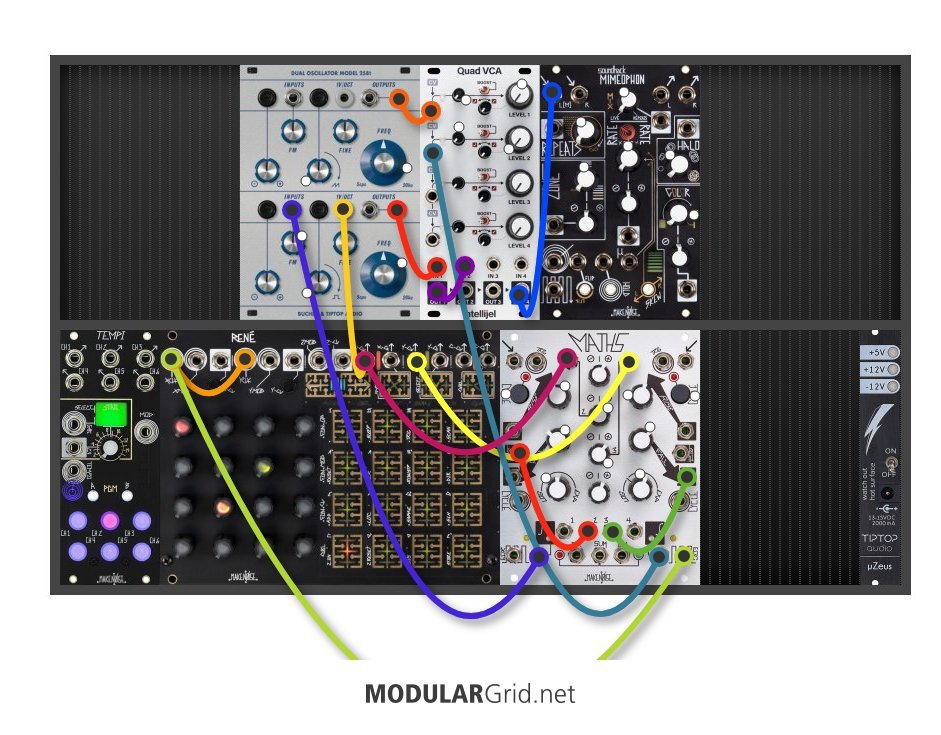This one uses a mix of AM and FM to create space sounds, and sometimes, with a bit of luck, bird tweets.
Video demonstration here:
Note the knob positions, marked by the white dots. Most of these can be played with to get quite a bit of range in the types of sounds, but I'd start around there first.
In this patch, it might be helpful to set it up in this order.
- Patch output of the bottom oscillator into Input 1 of the VCA. Patch the output of the top oscillator into the CV of channel 1. Turn the main level of channel 1 to 50%, and turn the CV attenuator to 100%.
- Patch Output of VCA's channel 1 to the input of Channel 2. Patch the output of Maths right channel into the CV of Channel 2. Set main level of channel to to 0%, and the CV attenuator to ~50%.
- Patch Output of VCA channel 4 to Mimeophon, but turn the mix down for now, so you can focus on what's happening before it gets affected by the Mimeophon.
- Hit the cycle button of Maths and adjust rise an fall until it opens the vca ~2 times a second. The exact length doesn't matter at this point, just make it slow enough that you can hear a sound ringing out. Adjust the frequency of both oscillators to very high pitches. The top oscillator should be a bit higher than the lower one. Adjust the relationship of the two until you get metallic or bell sounds
- Patch the output of Maths' left channel into the FM input of the bottom oscillator. Maths knobs at about 45%. Put it in cycle mode. Adjust the FM knob on the oscillator, so that you hear just a little bit of wavering in the pitch, but not so much that it's overwhelming.
- Now, let's get a little variation in this by bringing the Rene to modulate the rate of the Maths, as well as changing the pitch. Take the EOC (end of cycle) output of the right channel of Maths. It's the bottom right output. Patch this into the X clock input of Rene. Use a stackable cable to patch that same cable to the Y clock input. The EOC outputs a gate signal every time the Maths channel finishes. So the faster our Maths channel, the faster the Rene will advance.
- Patch the X CV output to the 1v/octave input of the bottom oscillator.
- We're going to use the use the Y channel CV to modulate the rate of the Maths. Patch the Y CV output to Math channel 3 input (it's the 4th input from the left on the top). Patch the channel 3 output to the Fall input of the right channel of Maths. Adjust channel 3 attenuator and Rise and Fall to taste. You should be getting some variation in rythym. Use a 4-5 lenth sequence on Rene's Y channel, and adjust its CV knobs to see how it affects the rythm. Higher values should result in longer envelopes.
- Use a stackable cable to patch the X channel CV output to Maths channel 2 input (3rd input from left on top). Connect channel 2 output to the both intpu of Maths left channel (it's the middle one, 2nd input below the cycle button). Adjust the attenuator for channel to to the left to get some variation in the FM. Higher pitches should have a faster tremolo than lower pitches.
- Turn up the mix on the Mimeophon and explore
Play with:
- Oscillator frequency
- Maths rise and fall on both channels.
- CV of both X & Y channels of Rene
- Sequence length on Rene X & Y channels
- Attenuators for Maths channel 2 and 3
- Mimeophone settings


